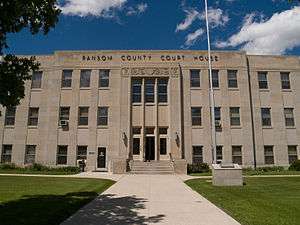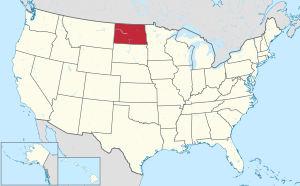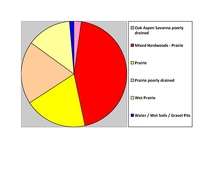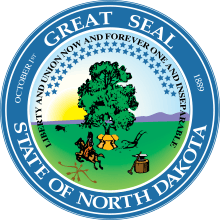Ransom County, North Dakota
Ransom County is a county in the U.S. state of North Dakota. As of the 2010 United States Census, the population was 5,457.[1] Its county seat is Lisbon.[2]
Ransom County | |
|---|---|
 | |
 Location within the U.S. state of North Dakota | |
 North Dakota's location within the U.S. | |
| Coordinates: 46°28′N 97°40′W | |
| Country | |
| State | |
| Founded | January 4, 1873 (created) April 4, 1881 (organized) |
| Named for | Fort Ransom |
| Seat | Lisbon |
| Largest city | Lisbon |
| Area | |
| • Total | 864 sq mi (2,240 km2) |
| • Land | 862 sq mi (2,230 km2) |
| • Water | 1.4 sq mi (4 km2) 0.2% |
| Population (2010) | |
| • Total | 5,457 |
| • Estimate (2019) | 5,218 |
| • Density | 6.3/sq mi (2.4/km2) |
| Time zone | UTC−6 (Central) |
| • Summer (DST) | UTC−5 (CDT) |
| Congressional district | At-large |
| Website | www |
History
The Dakota Territory legislature created Ransom County on January 4, 1873. It was so named due to its military fort, which had been named Fort Ransom for Civil War veteran Major General Thomas E.G. Ransom. The fort had operated between 1867 and 1872. The county was not organized at that time, nor was it attached to another county for administrative or judicial purposes. Its proposed boundaries were altered two times during 1881. On April 4, 1881 the county government was effected. The county's area was again reduced in 1883 when Sargent County was created. Ransom County has retained its present configuration since that time.[3][4]
Geography
The Sheyenne River meanders through Ransom County. The county terrain consists of rolling hills, dotted with lakes and ponds in its western part. The area is largely devoted to agriculture.[5] The terrain slopes to the east and south; its highest point is on the north boundary line near its NW corner, at 1,421' (433m) ASL.[6] The county has a total area of 864 square miles (2,240 km2), of which 862 square miles (2,230 km2) is land and 1.4 square miles (3.6 km2) (0.2%) is water.[7]

Major highways



Adjacent counties
- Cass County - northeast
- Richland County - east
- Sargent County - south
- Dickey County - southwest
- LaMoure County - west
- Barnes County - northwest
Protected areas
- Browns Ranch[8]
- Fort Ransom State Park
- Nature Conservancy's Sheyenne Delta[8]
- North Country Trail
- Pigeon Point Reserve[8]
- Sheyenne National Grassland (part)
- Sheyenne State Forest[8]
Lakes[5]
- Lone Tree Lake
Demographics
| Historical population | |||
|---|---|---|---|
| Census | Pop. | %± | |
| 1880 | 537 | — | |
| 1890 | 5,393 | 904.3% | |
| 1900 | 6,919 | 28.3% | |
| 1910 | 10,345 | 49.5% | |
| 1920 | 11,618 | 12.3% | |
| 1930 | 10,983 | −5.5% | |
| 1940 | 10,061 | −8.4% | |
| 1950 | 8,876 | −11.8% | |
| 1960 | 8,078 | −9.0% | |
| 1970 | 7,102 | −12.1% | |
| 1980 | 6,698 | −5.7% | |
| 1990 | 5,921 | −11.6% | |
| 2000 | 5,890 | −0.5% | |
| 2010 | 5,457 | −7.4% | |
| Est. 2019 | 5,218 | [9] | −4.4% |
| US Decennial Census[10] 1790-1960[11] 1900-1990[12] 1990-2000[13] 2010-2019[1] | |||
2000 census
As of the 2000 United States Census, there were 5,890 people, 2,350 households, and 1,560 families in the county. The population density was 6.83/sqmi (2.64/km²). There were 2,604 housing units at an average density of 3.02/sqmi (1.17/km²). The racial makeup of the county was 97.93% White, 0.19% Black or African American, 0.32% Native American, 0.25% Asian, 0.37% from other races, and 0.93% from two or more races. 0.81% of the population were Hispanic or Latino of any race. 39.5% were of German and 34.9% Norwegian ancestry.
There were 2,350 households out of which 31.00% had children under the age of 18 living with them, 58.10% were married couples living together, 5.10% had a female householder with no husband present, and 33.60% were non-families. 30.70% of all households were made up of individuals and 15.50% had someone living alone who was 65 years of age or older. The average household size was 2.39 and the average family size was 3.01.
The county population contained 25.00% under the age of 18, 5.90% from 18 to 24, 25.40% from 25 to 44, 22.40% from 45 to 64, and 21.20% who were 65 years of age or older. The median age was 41 years. For every 100 females there were 106.20 males. For every 100 females age 18 and over, there were 105.80 males.
The median income for a household in the county was $37,672, and the median income for a family was $44,865. Males had a median income of $35,023 versus $18,772 for females. The per capita income for the county was $18,219. About 6.30% of families and 8.80% of the population were below the poverty line, including 10.70% of those under age 18 and 8.20% of those age 65 or over.
2010 census
As of the 2010 United States Census, there were 5,457 people, 2,310 households, and 1,466 families in the county.[14] The population density was 6.33/sqmi (2.44/km²). There were 2,656 housing units at an average density of 3.08/sqmi (1.19/km²).[15] The racial makeup of the county was 97.8% white, 0.4% Asian, 0.4% American Indian, 0.3% black or African American, 0.1% Pacific islander, 0.1% from other races, and 0.9% from two or more races. Those of Hispanic or Latino origin made up 1.2% of the population.[14] In terms of ancestry, 54.2% were German, 36.6% were Norwegian, 9.0% were Irish, 6.9% were Swedish, 5.1% were English, and 1.6% were American.[16]
Of the 2,310 households, 27.8% had children under the age of 18 living with them, 54.8% were married couples living together, 5.4% had a female householder with no husband present, 36.5% were non-families, and 32.9% of all households were made up of individuals. The average household size was 2.28 and the average family size was 2.89. The median age was 45.2 years.[14]
The median income for a household in the county was $46,044 and the median income for a family was $59,973. Males had a median income of $42,380 versus $28,209 for females. The per capita income for the county was $21,995. About 7.5% of families and 9.4% of the population were below the poverty line, including 13.2% of those under age 18 and 11.6% of those age 65 or over.[17]
Communities
Cities
- Elliott
- Enderlin (partly in Cass County)
- Fort Ransom
- Lisbon (county seat)
- Sheldon
Townships
- Aliceton
- Alleghany
- Bale
- Big Bend
- Casey
- Coburn
- Elliott
- Fort Ransom
- Greene
- Hanson
- Island Park
- Isley
- Liberty
- McLeod
- Moore
- Northland
- Owego
- Preston
- Rosemeade
- Sandoun
- Scoville
- Shenford
- Springer
- Sydna
- Tuller
Politics
Ransom County is a swing county in presidential elections, having voted for both parties an equal number of times since 1980. It voted for the Democrat in the 2000 and 2012 gubernatorial elections, and for the Republican in 2004, 2008, and 2016.
Ransom County is one of the most Democratic counties in North Dakota. In the 2018 election for U.S. Senate, it gave Heidi Heitkamp her 4th-highest total (60.6%), behind only Sioux, Rolette, and Benson counties.
| Year | Republican | Democratic | Third parties |
|---|---|---|---|
| 2016 | 51.3% 1,210 | 35.5% 838 | 13.2% 311 |
| 2012 | 41.6% 1,009 | 55.4% 1,343 | 3.0% 73 |
| 2008 | 41.0% 998 | 56.4% 1,371 | 2.6% 64 |
| 2004 | 52.0% 1,352 | 46.1% 1,199 | 2.0% 51 |
| 2000 | 54.7% 1,488 | 39.7% 1,080 | 5.6% 151 |
| 1996 | 37.8% 920 | 49.2% 1,199 | 13.0% 316 |
| 1992 | 38.0% 1,102 | 40.2% 1,166 | 21.9% 635 |
| 1988 | 47.7% 1,362 | 51.1% 1,459 | 1.3% 37 |
| 1984 | 57.4% 1,706 | 41.1% 1,222 | 1.5% 45 |
| 1980 | 59.9% 1,883 | 31.0% 974 | 9.1% 285 |
| 1976 | 49.1% 1,696 | 49.6% 1,715 | 1.3% 45 |
| 1972 | 59.9% 2,056 | 39.5% 1,355 | 0.7% 24 |
| 1968 | 57.4% 1,943 | 38.0% 1,286 | 4.6% 154 |
| 1964 | 44.3% 1,647 | 55.5% 2,063 | 0.2% 7 |
| 1960 | 56.3% 2,324 | 43.7% 1,806 | 0.0% 1 |
| 1956 | 56.6% 2,361 | 43.3% 1,808 | 0.1% 5 |
| 1952 | 70.2% 3,051 | 29.1% 1,265 | 0.7% 31 |
| 1948 | 50.9% 1,772 | 45.8% 1,595 | 3.4% 118 |
| 1944 | 55.1% 2,044 | 44.2% 1,639 | 0.8% 29 |
| 1940 | 56.2% 2,579 | 43.3% 1,986 | 0.5% 24 |
| 1936 | 30.3% 1,303 | 55.5% 2,385 | 14.2% 610 |
| 1932 | 31.7% 1,445 | 66.3% 3,025 | 2.0% 93 |
| 1928 | 63.0% 2,613 | 36.3% 1,505 | 0.7% 27 |
| 1924 | 45.6% 1,862 | 7.4% 303 | 47.0% 1,919 |
| 1920 | 77.3% 3,010 | 20.6% 802 | 2.1% 82 |
| 1916 | 47.8% 1,093 | 49.0% 1,121 | 3.2% 72 |
| 1912 | 31.2% 495 | 30.9% 490 | 37.9% 601 |
| 1908 | 67.5% 1,308 | 30.0% 581 | 2.5% 48 |
| 1904 | 79.7% 1,257 | 16.0% 253 | 4.3% 68 |
| 1900 | 62.8% 924 | 33.9% 499 | 3.3% 49 |
References
- "State & County QuickFacts". United States Census Bureau. Retrieved November 1, 2013.
- "Find a County". National Association of Counties. Retrieved June 7, 2011.
- "Dakota Territory, South Dakota, and North Dakota: Individual County Chronologies". Dakota Territory Atlas of Historical County Boundaries. The Newberry Library. 2006. Retrieved February 4, 2015.
- "County History". North Dakota.gov. The State of North Dakota. Archived from the original on February 2, 2015. Retrieved February 4, 2015.
- Ransom County ND Google Maps (accessed 25 February 2019)
- ""Find an Altitude/Ransom County ND" Google Maps (accessed 25 February 2019)". Archived from the original on May 21, 2019. Retrieved February 26, 2019.
- "2010 Census Gazetteer Files". US Census Bureau. August 22, 2012. Archived from the original on January 29, 2015. Retrieved February 1, 2015.
- What to do
- "Population and Housing Unit Estimates". Retrieved April 2, 2020.
- "US Decennial Census". US Census Bureau. Retrieved February 1, 2015.
- "Historical Census Browser". University of Virginia Library. Retrieved February 1, 2015.
- Forstall, Richard L., ed. (April 20, 1995). "Population of Counties by Decennial Census: 1900 to 1990". US Census Bureau. Retrieved February 1, 2015.
- "Census 2000 PHC-T-4. Ranking Tables for Counties: 1990 and 2000" (PDF). US Census Bureau. April 2, 2001. Retrieved February 1, 2015.
- "Profile of General Population and Housing Characteristics: 2010 Demographic Profile Data". US Census Bureau. Archived from the original on February 13, 2020. Retrieved April 3, 2016.
- "Population, Housing Units, Area, and Density: 2010 - County". US Census Bureau. Archived from the original on February 13, 2020. Retrieved April 3, 2016.
- "Selected Social Characteristics in the US – 2006-2010 American Community Survey 5-Year Estimates". US Census Bureau. Archived from the original on February 13, 2020. Retrieved April 3, 2016.
- "Selected Economic Characteristics – 2006-2010 American Community Survey 5-Year Estimates". US Census Bureau. Archived from the original on February 13, 2020. Retrieved April 3, 2016.
- Leip, David. "Atlas of US Presidential Elections". uselectionatlas.org. Retrieved April 13, 2018.
External links
- Ransom County map, North Dakota DOT
